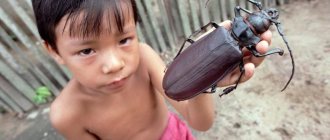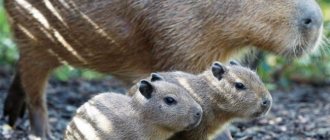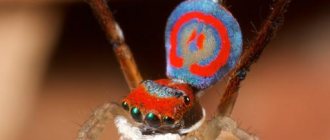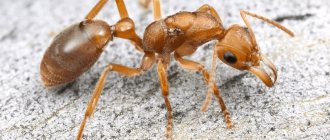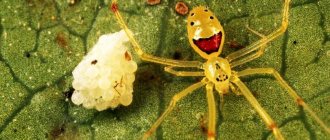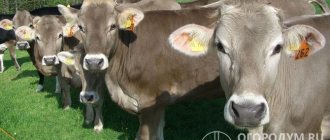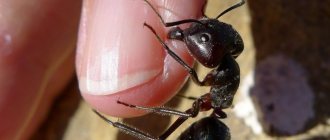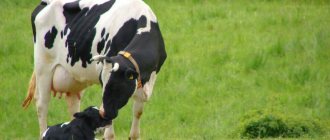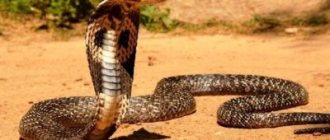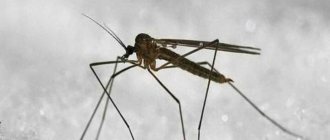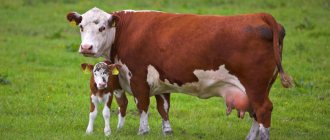Currently, there are several unique animals - giant bulls and cows, as well as very miniature cows, which cause genuine admiration among people. Today we have prepared material for you from which you will learn about the largest and smallest cows in the world. By the way, some of them are listed in the Guinness Book of Records, despite the fact that they do not show high productivity.
Giant animals
The largest cows in the world are distinguished by their majestic beauty, large body weight, and enormous height. According to their owners, they were able to achieve such results thanks to careful care and a balanced diet. Typically, such individuals do not have offspring; most often they are sterilized. After this procedure, the metabolic processes in the body change in animals. Often cows become like bulls. The animals' appetite improves, the size of their stomach increases, due to this they begin to consume more feed and gain weight faster. The animal's skeleton becomes much stronger. The largest cows in the world are distinguished by smooth and thick hair and thick skin. The color of bulls is brighter and more saturated than that of cows. Thanks to good care, animals have high immunity and a pronounced exterior characteristic of a certain breed. Giant cows are the pride of the entire country in which they live.
Montbeliardskaya, 600-820 kg
A very beautiful and graceful breed of cows. They produce a high-quality dairy product for quite a long time and their weight can reach 820 kilograms.
Cattle breeders in Switzerland and France have set themselves the goal of creating an unpretentious and hardy breed of cows with high productivity. They started in the 18th century, they managed to get a cow with all the necessary qualities only a century later.
In 1889, the Montbéliarde cow . Among all its relatives, this breed is considered the most elegant and therefore they take it to appear in videos about milk.
The largest cows and bulls in the world: breeds
One of the best cattle breeds is considered to be a breed of Italian selection - Chianina. It has been known since the times of Ancient Rome. Individuals of this breed are also called porcelain.
Animals of meat productivity, large size. The average weight of bulls is 1200 kg, cows - 1000 kg. Their height at the withers is 170 and 160 cm, respectively. The animals' fur is snow-white (sometimes cream-colored), very thick, and the skin is thick. A distinctive feature is the presence of voluminous folds on the neck. The calf weighs 45 kg at birth. Meat yield at slaughter is 65%. It has very high taste qualities. Cows do not have high milk production and produce no more than 1000 kg per lactation.
Bonobos
Height – 110-120 cm, weight – 40-61 kg.
Bonobos are also called pygmy chimpanzees; in fact, they belong to the same genus and were identified as a separate species relatively recently. Bonobos are not inferior in height to their closest relatives, but they are less wiry and broad-shouldered. They have small ears, a high forehead and parted hair.
Bonobos gained their popularity due to their behavior, which is unusual for the animal world. They are known as the most loving primates. They often resolve conflicts, avoid them, make peace, express emotions, and experience joy and anxiety in one way: by mating. However, this has little effect on population growth.
Unlike chimpanzees, bonobos are not so aggressive, they do not hunt together, males are tolerant of cubs and adolescents, and the female is at the head of the pack.
Record holder Blossom
The largest Holstein Friesian cow in the world lives in America in the state of Illinois. Blossom is noted in the Guinness Book of Records, as she is the tallest in the world: her height at the withers is 193 cm. Once upon a time, neighbors advised the owner of the cow, Patty Henson, to send this giant animal to the slaughterhouse. The thing is that Blossom was infertile, and therefore could not give her mistress either milk or offspring. But Patty became very attached to the cow and kept it as a pet. How much does the largest cow in the world weigh? Its weight is just over a ton - 1300 kg. The giant animal made Orangeville famous throughout the world. Very often people come here from all over the world to look at this amazing cow.
Tagilskaya
Cows of this breed can produce up to 5,000 liters of milk per year, but meat types are still more valued among farmers. Due to selection, it was possible to achieve indicators of 530–590 kg of live weight.
There are various colors available. The body is massive with strong legs and a broad chest. Almost all individuals have strong bones and high resistance to various diseases. They easily tolerate changes in weather conditions, and in the summer it is profitable and economical to maintain them.
Farmers note that they do not require special care and expensive nutrition. The main thing is cleanliness in the places of detention. They have an easy-going and calm disposition and easily get used to their owner.
It's time to get acquainted with the largest cows, whose owners claim that such results were achieved thanks to care, care and a balanced diet. Well, thebiggest will tell you how much the record-breaking cows weigh.
Burenka named Rio
The world's second largest cow, Rio, lives in Dorset, in the south of England. This beauty is a representative of the Holstein breed. According to some parameters, she is slightly inferior to the cow from the USA - Blossom. Rio's height at the withers is 180 cm, and her weight is 1.25 tons. The cow has a bad character: she is very wayward and active. To prevent her from harming people, she even had to remove her horns. She has no offspring and, accordingly, does not produce milk. The animal is fed 3 times a day. The diet includes fodder, sunflower meal, hay, mineral and vitamin supplements, and grain. Hormonal drugs intended for accelerated growth and rapid weight gain are not used when feeding cows.
Mountain gorilla
Height – 100-150 cm, weight – up to 180 kg.
The top three are, of course, representatives of the genus of gorillas - mountain gorillas. They live in a relatively small area of the Great Rift Valley in Central Africa, at an altitude of 2-4.3 thousand meters above sea level.
Mountain gorillas have almost 30 differences from other species, but the most obvious are thicker hair and powerful nuchal ridges where the chewing muscles are attached. Their color is black, they have brown eyes with a black iris frame.
They live mainly on the ground, moving on four powerful legs, but are able to climb trees, especially teenagers. They feed on plant foods, with leaves, bark and grass making up most of the diet. An adult male is capable of eating 30 kg of vegetation per day, while the appetite of females is more modest - up to 20 kg.
Trigger - giant bull
There is another outstanding individual in Britain - a huge bull named Trigger. It belongs to the Fresian breed, which at one time was bred from porcelain. He grew to 196 cm at the withers and gained weight of 1.2 tons. The record holder amazes everyone with his size: the distance from nose to tail is 4.3 m. The bull continues to rapidly gain weight and, perhaps, will soon take its rightful place in the Guinness Book of Records. Like other giant bulls, Trigger has a quiet, calm character.
Limousinskaya, 700 kg
This breed takes a well-deserved place in the rankings of the largest cows. The meat of the Limousin cow is traditionally considered the most delicious. It originally comes from France and is still grown there. It received this name because of the area in France where cattle were first bred.
Australians and Latin Americans have also succeeded in breeding Limousin cows. The color of cows can be several shades of golden brown and red. There is a single herd of Limousin cows that are colored black. Cows grow up to 700 kilograms, which makes them a serious item in the export of meat products.
Representative of the Fresian breed
Among the world's largest cows, or rather bulls, there is another representative of the Fresian breed - a huge bull named Chili. The weight of the animal reaches 1300 kg. In 1999, he was found in an animal shelter in Fern, England, only 6 days old and severely malnourished. Over the course of a year, this animal gains up to 100 kg of weight. Chile is included in the Guinness Book of Records. Outwardly, he does not look massive or scary, he has a gentle and affectionate character. In appearance, Chili looks more like the largest cow in the world.
Repp is the best producer
The photo of the world's largest inseminating bull of the Podolsk breed is striking. This huge creature is called Repp, lives at a breeding center near Cherkassy in Ukraine. Weight is more than 1.5 tons. It grew to its impressive size naturally, thanks to free housing and proper nutrition. Mainly eats hay, likes soy, a little sugar.
Every year, about 50 thousand healthy, viable calves are obtained from him using artificial insemination of cows. Farmers are afraid to bring cows for a personal meeting with the curly-haired handsome man because of his impressive size and unpredictable behavior. The Ox does not tolerate disrespect and is slightly touchy towards people.
Field Marshal - giant bull
One of the leading positions is occupied by a rare Charolais breed bull named Field Marshal.
His height is 190 cm, and his weight is as much as 1700 kg. The owner of the English farm and this animal, Arthur Dachetti, purchased the bull at the breeding market. But I didn’t even imagine that it would reach such a size. The field marshal has a balanced character and an easy-going disposition.
Tagilskaya, 530-590 kg
This breed was bred back in the 18-19th century. In the Urals, local cattle were crossed with Dutch breeds and they noticed that the crossing had a beneficial effect on the structure and mammary glands. Thus, the Tagil breed was developed in several stages . Her weight is from 500 kilograms and she is short in stature.
The most common are black and black and white, but the color of this breed varies. The main advantage of this breed is its unpretentiousness to the environment. She gets along well in harsh climates and does not lose milk production. In addition, they are very easy to breed.
Indian cows
Indian vechur cows were quite recently on the verge of extinction, but thanks to complex breeding work it was possible to preserve this breed. Note that this took about 25 years. Cows of this breed grow no more than 80-100 cm, their weight does not exceed 200 kg. They adapt well to the local climate, have a long lifespan and small size, all this makes these animals truly priceless. Despite their small size, you can get about 4 liters of milk per day from each.
Black and white, 650 kg
This is the color that can most often be seen on TV or in illustrations of children's books. They are classified as purebreds. Such cows are divided into two types: black-and-white of the Urals and black-and-white of Siberia . Milk productivity of the second type is several times higher than that of the Ural.
These cows are perfectly acclimatized to any living conditions, and they also have excellent health, which is why they are most valued. But despite all this, they are very demanding in their conditions of detention, so they need to be looked after more carefully and carefully.
Photo gallery
Photo 1. Cow Blossom with her owner
Photo 2. Vechur - the smallest breed of cows
Photo 3. Manikyam and her owner
Photo 4. White Chianina cow
Weighing methods
Breeding rams (sheep) involves individual assessment of their productive and breeding characteristics on a regular basis. As part of the assessment manipulations, the animal’s compliance with a set of established traits is monitored, which includes monitoring weight gain.
Control of the weight parameters of a ram is one of the main points that make up the list of rules for their breeding. Tracking growth progress is necessary to determine the cost-effectiveness of maintenance. Analysis of the weight gain graph allows you to find out the ratio of costs associated with feeding, ensuring proper living conditions and material profit, which includes covering the corresponding costs.
To determine the weight of a ram, certain equipment or a special calculation formula can be used to find the approximate value of this indicator. The second option is among the most preferred for mid-level farmers. This is due to the absence of the need to purchase expensive weighing equipment, incur costs associated with its installation and configuration, and other related factors.
The main measurement parameter is the size of the animal's chest circumference. Measurements are taken behind the front legs and shoulder blades. The tension of the measuring tape is of great importance, since hair can interfere with the accuracy of the measurement.
The obtained value is used as one of the variables in the formula for calculating the live weight of the ram. There are many such formulas, which increases the spread of calculation accuracy and reduces the efficiency of measurement manipulations. Given this, most farmers use a special measuring tape. It contains metric parameters and weight values corresponding to these parameters. The numbers indicating the mass of the animal can be supplemented with several values corresponding to the weight characteristics of different breeds of sheep. The belonging of a particular numerical name to a suitable numerical column is indicated by the corresponding color.
Giants of the wild forests
The largest bull in the world is found in the dense thickets of South Asian countries. These are Indian bison, or gaura bulls. They are often found in mountain forests or bamboo groves in small groups. Sometimes a small herd may consist of only young bulls, but more often it is a dozen cows, calves and several males. The leader of the herd is usually an old cow. Many adult males leave and live separately.
Three-meter beauties with huge curved horns reach a weight of one and a half tons and have almost no natural enemies. At the same time, their numbers are critically small; the animals are listed in the Red Book. This is due to poachers, as well as changes in natural habitat conditions and the propensity of Asian bison to infectious diseases. Plague and foot-and-mouth disease cause great losses to the gaur population.
